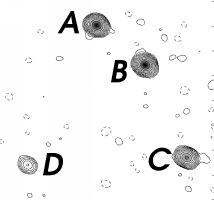References
Click here to see the CASTLES data available for this object, or here to search for references on NED. You can go to a paper's abstract on ADS by clicking its reference number.
-
[1] B1422+231 - A new gravitationally lensed system at Z = 3.62, A. R. Patnaik et al., Mon. Not. R. Astron. Soc. (ISSN 0035-8711), vol. 259, no. 1, p. 1P-4P. (1992)
-
[2] Infrared observations of the gravitational lens system B1422+231, C. R. Lawrence et al., Mon. Not. R. Astron. Soc, (ISSN 0035-8711), vol. 259, no. 1, p. 5P-7P. (1992)
-
[3] Optical imaging of the gravitational lens system B 1422+231, M. Remy et al., Astron. & Astrophys. (ISSN 0004-6361), vol. 278, no. 1, p. L19-L22 (1993)
-
[4] High resolution optical imaging of the gravitational lens system B1422+231, H. K. C. Yee and E. Ellingson, Astron. J. vol. 107, no. 1, p. 28-34 (1994)
-
[5] Imaging and spectroscopy of B 1422+231 at C.F.H.T.: identification of the mirage and of the lensing galaxy at z= 0.647, F. Hammer et al., Astron. & Astrophys. v.298, p.737 (1995)
-
[6] Variability in the Gravitational Lens System B1422+231, H. K. C. Yee and J. Bechtold, Astron. J. v.111, p.1007 (1996)
-
[7] Hubble Space Telescope Observations of the Gravitational Lens System B1422+231, C. D. Impey et al., Astrophys. J. Let. v.462, p.L53 (1996)
-
[8] Redshifts of the gravitational lenses B1422+231 and PG 1115+080, J. L. Tonry, Astron. J. vol. 115, p. 1 (1998)
-
[9] VLBI Observations of the Gravitational Lens B1422+231, A. R. Patnaik & R. W. Porcas, Radio Emission from Galactic and Extragalactic Compact Sources, ASP Conference Series, Vol. 144, IAU Colloquium 164, eds. J.A. Zensus, G.B. Taylor, & J.M. Wrobel, p. 319. (1998)
-
[10] Milliarcsec-scale polarization observations of the gravitational lens B1422+231, A. R. Patnaik et al., Mon. Not. R. Astron. Soc. 307, p.L1 (1999)
-
[11] Gravitationally lensed radio sources in the Jodrell Bank-VLA Astrometric Survey, L. J. King et al., Mon. Not. R. Astron. Soc. 307, pp. 225-235 (1999)
-
[12] Determination of time delay from the gravitational lens B1422+231, A. R. Patnaik and D. Narasimha, Mon. Not. R. Astron. Soc. 326, Iss. 4, p. 1403 (2001)
-
[13] B1422+231: The influence of mass substructure on strong lensing, M. Bradac et al., Astron. & Astrophys. 388, pp. 373-382 (2002)
|
